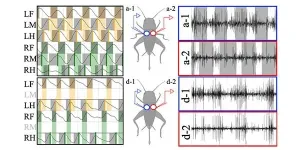How insects activate muscles to adapt to limbs removed
2021-01-14
(Press-News.org) Adaptability explains why insects spread so widely and why they are the most abundant animal group on earth. Insects exhibit resilient and flexible locomotion, even with drastic changes in their body structure such as losing a limb.
A research group now understands more about adaptive locomotion in insects and the mechanisms underpinning it. This knowledge not only reveals intriguing information about the biology of the insects, but it can also help to design more robust and resilient multi-legged robots that are able to adapt to similar physical damage.
The insect nervous system is comprised of approximately 105 to 106 neurons. Understanding the process behind this requires researchers to consider the role of the intrinsic neural circuits that influence the adaptions of insects under unfavorable circumstances and the sensory feedback mechanisms reflected in their body characteristics and physical interactions with the environment.
A research group comprising associate professor Dai Owaki from Tohoku University's Department of Robotics at the Graduate School of Engineering and associate professor Hitoshi Aonuma from the research institute of electronic science at Hokkaido University simultaneously recorded the leg movements and muscle activation of crickets, both before and after middle leg amputation.
Their findings showed that the walking manner of crickets shifted from a tetrapod/tripod gait to a four-legged trot after the middle leg had been removed.
Electromyogram (EMG) analysis of the muscles at the base of the middle leg revealed that the muscles were active in opposite phases when walking. Activation timing of the middle leg muscles synchronized in phase when both legs had been removed, whereas the activation timing showed anti-phase synchronization for crickets with all of their legs.
The findings demonstrated two things. First, an intrinsic contralateral connection exists within the mesothoracic ganglion, which generates in-phase synchronization of muscle activation. Second, mechanoreceptive informational feedback from the campaniform seensilla of the legs overrides the centrally generated patterns, resulting in the anti-phase leg movements of a normal gait.
"Our results will pave the way for the further understand of the leg coordination mechanism in insect locomotion," said professor Dai Owaki. "It may also aid design principles for a decentralized controller that enables flexible and adaptive walking in an insect-like-six-legged robot."
INFORMATION:
[Attachments] See images for this press release:

ELSE PRESS RELEASES FROM THIS DATE:
2021-01-14
Posidonia oceanica seagrass -an endemic marine phanerogam with an important ecological role in the marine environment- can take and remove plastic materials that have been left at the sea, according to a study published in the journal Scientific Reports. The article's first author is the tenure-track 2 lecturer Anna Sànchez-Vidal, from the Research Group on Marine Geosciences of the Faculty of Earth Sciences of the University of Barcelona (UB).
The study describes for the first time the outstanding role of the Posidonia as a filter and trap for plastics in the coastal areas, and it is pioneer ...
2021-01-14
Both past and present-day scientists have suspected the intestines of playing a role in various diseases. Present-day studies focus on the intestinal flora's role in physical diseases such as diabetes and overweight, while others seek to establish a connection between the intestinal flora and e.g. autism, schizophrenia and depression. But even modern-day scientists have difficulties studying the around 500-1000 different species among the approx. 100 billion active bacteria in our intestines.
Therefore, researchers from the University of Copenhagen have developed a ground-breaking technique that ...
2021-01-14
Roughly 8,200 years ago, the island of Yuzhniy Oleniy Ostrov in Lake Onega in the Republic of Karelia, Russia, housed a large burial ground where men, women and children of varying ages were buried. Many of the graves contain an abundance of objects and red ochre, signifying the wish to ensure the comfort of the buried also after death. Pendants made of elk incisors were apparently attached to clothing and accessories, such as dresses, coats, cloaks, headdresses and belts. Although no clothing material has been preserved, the location of the elk teeth sheds light on the possible type of these outfits.
A people of grooved elk tooth pendants
A study headed by archaeologist Kristiina Mannermaa, University of Helsinki, aimed to determine who ...
2021-01-14
Bacteria are likely triggering greater melting on the Greenland ice sheet, possibly increasing the island's contribution to sea-level rise, according to Rutgers scientists.
That's because the microbes cause sunlight-absorbing sediment to clump together and accumulate in the meltwater streams, according to a Rutgers-led study - the first of its kind - in the journal Geophysical Research Letters. The findings can be incorporated in climate models, leading to more accurate predictions of melting, scientists say.
"These streams can be seen all over Greenland ...
2021-01-14
In patients with bladder cancer, chemotherapy effectiveness is partially determined by the body's immune system response to the malignancy. This is the conclusion of research conducted by a team of scientists from Charité - Universitätsmedizin Berlin and the Berlin Institute of Health. The findings, which have been published in Science Translational Medicine*, can be used to predict treatment success and may increase survival in patients with bladder cancer.
Bladder cancer is one of the ten most common types of cancer in Germany, and one of the five most common cancers in men. Nationwide, the disease affects approximately 30,000 people a year. The risk of the cancer ...
2021-01-14
TAMPA, Fla. -- The hallmarks of cancer include rapid cell reproduction and metabolic activity. But these processes also lead to increased cellular stress and oxidation, and the risk of cell death. To circumvent these negative consequences of supercharged growth, cancer cells stimulate pathways to reduce oxidative stress and avoid cell death. In an article published in Cell Metabolism, Moffitt Cancer Center researchers report on a newly discovered biochemical pathway that protects cells from a type of cell death called ferroptosis.
Ferroptosis is a specialized type of cell death that is caused ...
2021-01-14
Scientists at the Walter Reed Army Institute for Research have shown that microRNA biomarkers related to Alzheimer's disease play a role in brain damage caused by traumatic brain injury.
TBI or brain trauma results from blows to the head, leading to chronic disruption of the brain and a cascade of long-term health conditions. Patients who suffer from TBI are at much higher risk of developing neurodegenerative disease or dementia, particularly Alzheimer's disease. The mechanism behind this relationship remains understudied, making the development effective therapeutics challenging.
MiRNAs are small pieces of genetic material that play a critical role in normal gene expression. Yet, studies have also linked abnormal miRNA levels, or dysregulation, to a range of diseases including neurodegenerative ...
2021-01-14
Recently, the research team led by academician GUO Guangcan from the University of Science and Technology of China of the Chinese Academy of Sciences has made security analysis and improvement of source independent quantum random number generators with imperfect devices.
By studying the actual characteristics of the measurement devices of the source-independent quantum random number generation, the researchers pointed out that the security issues were caused by afterpulse, detection efficiency mismatching, poor sensitivity to photon number distribution ...
2021-01-14
Researchers at McGill University have identified a new cellular pathway that limits the growth and spread of brain tumors by controlling the recycling of cell surface receptor proteins. The study, which will be published January 14 in the Journal of Cell Biology (JCB), suggests that the pathway, which involves a protein called Rab35, is defective in many patients with glioblastoma and that restoring Rab35's activity could be a new therapeutic strategy for this deadly form of brain cancer.
Glioblastoma is the most aggressive type of brain cancer, and because it is largely untreatable, the average patient dies within 14 months of diagnosis. Like in other cancers, the proliferation and spread of glioblastoma cells depends on various receptor proteins on the outside of the cell. The ...
2021-01-14
While humans may struggle to navigate a murky, turbid underwater environment, weakly electric fish can do so with ease. These aquatic animals are specially adapted to traverse obscured waters without relying on vision; instead, they sense their environment via electric fields. Now, researchers are attempting to adapt these electrosensing techniques to improve underwater robotics.
Scientists have spent years studying how weakly electric fish--including the knife fish and elephantnose fish--utilize electricity for navigation. These fish have specialized electric organs that discharge small voltages into the surrounding water, creating their own personal electric fields. Nearby objects cause slight disruptions to these fields, which the fish detect with sensitive organs ...
LAST 30 PRESS RELEASES:
[Press-News.org] How insects activate muscles to adapt to limbs removed






